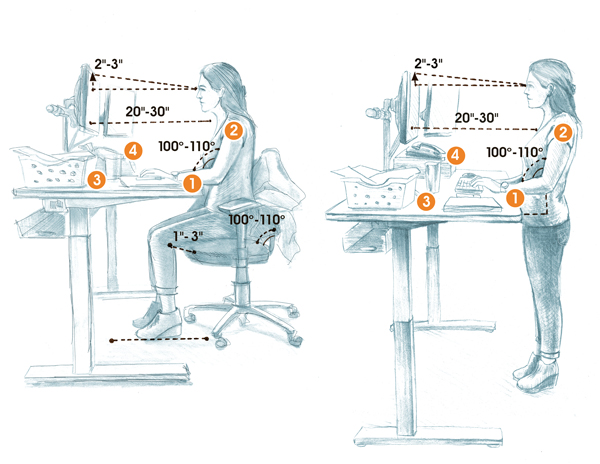As a nurse, the way you work is always evolving, whether that means changes in technology, workspace, or workflow. You’ve probably already experienced dizzying shifts, big and small, at your hospital or clinic.
For example, cube walls are being taken down and closed door offices are becoming a thing of the past. More than ever, the healthcare workplace is focused on open spaces, designed to encourage teamwork among nurses, doctors, aides and other staff members. Collaboration, it appears, is the new normal.
Also, due to the explosion of mobile devices such as smartphones and tablets, nurses aren’t tied to a nurses’ station anywhere. They’re increasingly working at the patient bedside, on the way to work, or from home, instead of at a standard workstation. This shift to a “work anywhere, work everywhere” mindset presents new challenges when it comes to nurse comfort, safety, and productivity.
As nurses become more mobile, every space needs to be an ergonomic space. Ergonomics, though, is not a one-size-fits-all endeavor — what optimizes one nurse’s well-being and efficiency may not work for another. So, the trick is to do what makes you feel most comfy and productive during the workday. That will always be the best kind of ergonomics.
On of the easiest and healthiest things you can do at work is to minimize the time you spend sitting. The American Medical Association and other health organizations recenlty came forth to advise that we sit less.
Why?
Standing enlivens our physiology and protects us from certain diseases, such as cancer. It also burns more calories than sitting, an average of 50 calories an hour. The exact number will vary based on your height, weight, and so forth, so check out this online Calorie Crunch app for a personalized estimate.
As a nurse, you many have thought you were impervenious to the dangers of sitting. After all, you spend plenty of time on your feet caring for patients. Many nurses, though, have been surprised to find after wearing a pedometer that they’re more sendentary at work than they suspected.
So, when doing paperwork or inputting patient data, say, try to shake things up by getting up off of that chair. Here are some guidelines, but it’s more important to do what makes you feel comfortable!
* When typing — whether sitting or standing — float your arms above the keyboard and keep your wrists straight.
* Relax your shoulders and keep everything you need close by to avoid pretzeling into awkward positions.
* When the phone rings, take that as a signal to stand up and talk.
* If you talk on the phone a lot, use a headset to avoid neck strain.
* When standing, a 4”-6” high footrest will arch your lower back and combat fatigue.
* Try taking walking meetings — or at least suggest them to your team.
* You don’t have to wait for administrators to buy standing desks or treadmill desks. Get your self an under-desk stairstepper or eliptical unit for $25 to $75. A small investment in your health.
* Try out various desktop or smart phone fitness apps to get you up and moving!
How about your workplace? Do you have standing desks or other ways to vary your posture throughout the day? Let us know!
Jebra Turner often writes about workplace health and safety. Visit her at www.jebra.com.
- Resumes, LinkedIn, and HR Portal Profiles, Oh My! - May 22, 2020
- Weight Management for Nurses: The Why’s and How’s of Losing or Maintaining Weight - February 18, 2020
- Mindfulness and Wellness Programs for Patients - October 14, 2019



